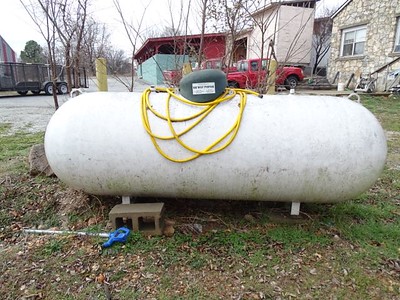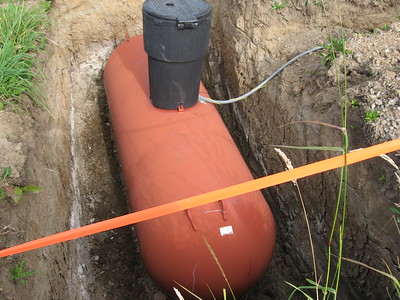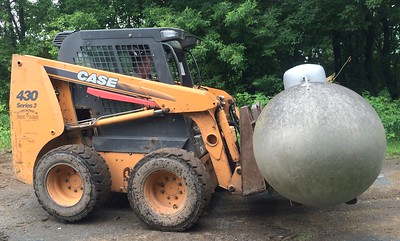
You can transport a 250 gallon propane tank, but there are a few things to keep in mind. First, you’ll need a truck or trailer that can accommodate the size and weight of the tank. Second, you’ll need to ensure that the tank is properly secured during transport. And third, you’ll need to be aware of any regulations that may apply in your area.
Assuming you have a suitable truck or trailer, the next step is to secure the tank. This can be done by chaining or strapping it down so it doesn’t shift during transport. You’ll also want to make sure the valve is closed and the tank is properly vented so that there is no risk of explosion.
Finally, be sure to check with your local authorities to see if there are any regulations regarding the transport of propane tanks. In some areas, a permit may be required. Following these simple tips will help ensure that your 250 gallon propane tank arrives safely at its destination.
4 Methods to Do It
| Method | Pros | Cons |
|---|---|---|
| Flatbed Truck | Capacity and Stability Accessibility Versatility |
Weather Exposure Security |
| Specialized Propane Tank Hauler | Custom Design Secure Transport Professional Handling |
Availability Cost |
| Towing with a Trailer | Flexibility Convenience |
Limited Capacity Handling Skills |
| Enclosed Truck Transport | Protection from Elements Security |
Loading and Unloading Challenges Space Limitations |
Importance of Proper Transport of Propane Tanks
Proper transport of propane tanks is important because it helps to ensure the safety of the tanks and the people handling them. Propane is a flammable gas and can be dangerous if not handled properly. Therefore, it is important to follow certain guidelines when transporting propane tanks to help minimize the risk of accidents or injuries. Some of the key considerations for the proper transport of propane tanks include:
- Ensuring that the tanks are secured properly in the transport vehicle to prevent them from shifting or falling over
- Handling the tanks carefully to avoid damaging them or causing them to leak
- Avoiding exposing the tanks to extreme temperatures or other harsh conditions that could damage them
- Keeping the tanks away from open flames or other sources of ignition
- Following any specific transport regulations or guidelines that may be applicable in your area
By following these guidelines and taking proper precautions, you can help to ensure the safe transport of propane tanks and minimize the risk of accidents or injuries.
You Cannot Transport the Propane Tank If It Has Propane In It
It is generally not safe or legal to transport a propane tank that has propane in it. Propane is a flammable gas and can be dangerous if not handled properly. If a propane tank is not properly vented or if it is exposed to heat or other sources of ignition, it could potentially explode or catch fire, which could cause serious injuries or damage. Therefore, it is generally not recommended to transport a propane tank that has propane in it.
If you need to transport a propane tank that has propane in it, it is generally best to have the propane gas removed from the tank by a qualified professional before attempting to transport it. This can help to ensure the safety of the tank and the people handling it, and it can also help to minimize the risk of accidents or injuries. Once the propane has been removed from the tank, it is generally safe to transport the tank, as long as it is handled carefully and all applicable laws and regulations are followed.
Regulations for Transporting a 250 Gallon Propane Tank
When you need to move a 250 gallon propane tank, you’ll need to take some extra precautions. First, call your local DOT office and fire department to let them know you’ll be transporting the tank. They may have some specific regulations that you’ll need to follow.
Call Your Local DOT Office To Check
It is generally a good idea to check with your local Department of Transportation (DOT) office when transporting a propane tank, as there may be specific regulations or guidelines that you need to follow. The DOT is responsible for regulating the transportation of hazardous materials, including propane, and they may have specific requirements for the transport of propane tanks depending on your location. Some of the things that you may need to consider when transporting a propane tank include:
- Ensuring that the tank is properly secured in the transport vehicle to prevent it from shifting or falling over
- Handling the tank carefully to avoid damaging it or causing it to leak
- Avoiding exposing the tank to extreme temperatures or other harsh conditions that could damage it
- Keeping the tank away from open flames or other sources of ignition
- Following any specific transport regulations or guidelines that may be applicable in your area
By checking with your local DOT office and following these guidelines, you can help to ensure the safe transport of your propane tank and minimize the risk of accidents or injuries.
Call Your Local Fire Department
If you are transporting a propane tank, it is important to call your local fire department. The fire department will be able to provide you with a list of safety precautions that you need to take. They will also be able to help you if there is an accident.
When transporting a propane tank, always call your local fire department for assistance. Propane is a highly flammable gas, and even a small leak can be dangerous. The fire department will have the proper equipment to safely transport the propane tank and will be able to provide any necessary assistance.-
Best Practices for Transporting a 250-Gallon Propane Tank
Here are some additional best practices for transporting a 250-gallon propane tank:
- Follow all applicable laws and regulations: Make sure to check with your local Department of Transportation (DOT) office and follow any specific guidelines or regulations that apply to the transport of propane tanks in your area.
- Use a specialized trailer or truck: It is generally best to use a specialized trailer or truck that is designed to transport propane tanks. These vehicles are equipped with features such as restraints and tie-downs to help secure the tank and prevent it from shifting or falling over during transport.
- Use appropriate restraints: Use appropriate restraints, such as straps or chains, to secure the propane tank in the transport vehicle. Make sure the restraints are tightened properly and are in good condition to ensure the tank is held securely in place.
- Ensure the tank is properly vented: Make sure that the propane tank is properly vented to prevent any build-up of pressure inside the tank. This can help to minimize the risk of leaks or other issues during transport.
- Handle the tank carefully: Be sure to handle the propane tank carefully to avoid damaging it or causing it to leak. Avoid dropping or rough handling of the tank, and be mindful of any sharp or rough surfaces that could potentially damage the tank.
By following these best practices, you can help to ensure the safe transport of your 250-gallon propane tank and minimize the risk of accidents or injuries.
To Make a Conclusion
Transporting a 250 gallon propane tank requires careful planning and attention to detail. The first step is to choose the right vehicle for the job. A truck or SUV with a large cargo area is ideal. The next step is to secure the tank in the vehicle. It should be placed in an upright position and secured with straps or chains to prevent it from shifting during transport. The third step is to plan your route carefully, avoiding any sharp turns or bumps that could jar the tank and cause a leak.
When you arrive at your destination, it is important to unload the propane tank carefully. Again, it should be placed in an upright position and secured with straps or chains. Once the tank is in place, you should inspect it for any signs of damage or leaks. If everything looks good, you’re ready to start using your propane tank!
When you need to transport a 250 gallon propane tank, it’s important to call the DOT office and fire department in your area. This will ensure that your tank is properly secured and that you have the proper permits.

Mike is an experienced propane technician with over 15 years of professional experience in the field. He has dedicated his career to helping customers with their propane needs, from installation to maintenance and repair. Together with Jeremy, he co-founded this website to provide useful information and guidance to customers seeking reliable propane services.




